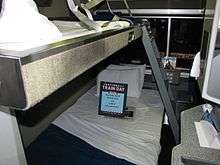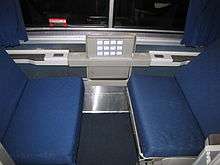Superliner (railcar)
| Superliner | |
|---|---|
.jpg) Superliner I cars on the San Francisco Zephyr in November 1980 | |
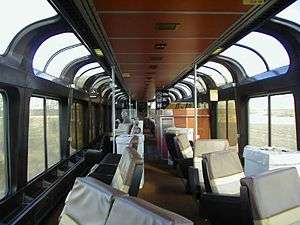 Interior of a Superliner I Sightseer lounge | |
| Manufacturer |
|
| Constructed |
|
| Entered service | 1979 |
| Number built | 479 |
| Operator(s) | Amtrak |
| Line(s) served | Auto Train, California Zephyr, Capitol Limited, City of New Orleans, Coast Starlight, Empire Builder, Heartland Flyer, Pere Marquette, Southwest Chief, Sunset Limited, and Texas Eagle |
| Specifications | |
| Car length | 85 ft 0 in (25.91 m) |
| Width | 10 ft 2 in (3.10 m) |
| Height | 16 ft 2 in (4.93 m) |
| Platform height | 8 in (203.2 mm) to 21.7 in (551.2 mm) |
| Entry | Step |
| Doors | 1 |
| Maximum speed | 100 mph (160 km/h) |
| Weight | 151,235–174,000 lb (68,599–78,925 kg) |
| Power supply | 480 V AC 60 Hz |
| Bogies |
|
| Braking system(s) | Air |
| Track gauge | 4 ft 8 1⁄2 in (1,435 mm) standard gauge |
The Superliner is a type of bilevel intercity railroad passenger car used by Amtrak, the national rail passenger carrier in the United States. Amtrak ordered the cars to replace older single-level cars on its long-distance trains in the Western United States. The design was based on the Budd Hi-Level vehicles, employed by the Santa Fe Railway on its El Capitan trains. Pullman-Standard built 284 cars, known as Superliner I, in 1975–1981; Bombardier Transportation built 195, known as Superliner II, in 1991–1996. The Superliner I cars were the last passenger cars built by Pullman.
Car types include coaches, dining cars, lounges, and sleeping cars. Most passenger spaces are on the upper level, which feature a row of windows on both sides. The Sightseer Lounge observation cars have distinctive floor-to-ceiling windows on the upper level. Boarding is on the lower level; passengers climb up a center stairwell to access the upper level.
The first Superliner I cars entered service in February 1979, with deliveries continuing through 1981. Amtrak assigned the cars to both long-distance and short-distance trains in the Western United States. The first permanent assignment, in October 1979, was to the Chicago–Seattle Empire Builder. Superliner II deliveries began in 1993; the additional cars enabled the retirement of the aging Hi-Level cars and the assignment of Superliners to trains in the Eastern United States. Tunnel clearances prevent their use on the Northeast Corridor.
Background
On May 1, 1971, Amtrak assumed control of almost all private sector intercity passenger rail service in the United States, with a mandate to reverse decades of decline. It retained about 184 of the 440 trains which had run the day before.[1] To operate these trains, Amtrak inherited a fleet of 300 locomotives and 1,190 passenger cars, most of which dated from the 1940s and 1950s.[2] No new sleeping cars had been built for service in the United States since 1955.[3]
Conventional single-level cars made up most of Amtrak's inherited fleet, but it also included 73 Hi-Level cars from the Santa Fe.[4] The Budd Company built these between 1954 and 1964; the bilevel design, with its superior views and smooth riding characteristics, was well-suited to the long distances in the west. Michael R. Weinman, who worked at the design firm Louis T. Klauder & Associates, recalled that when Amtrak issued a request for proposal (RFP) in 1973 for a "totally new" passenger car, it "was assumed" that the design would be bilevel.[5] Thirteen companies responded to the RFP; Amtrak selected the Klauder proposal. The design was finished by mid-1974 and Amtrak invited four companies to bid on its construction: Boeing, Budd, Pullman-Standard, and Rohr. Pullman-Standard won the contract.[6]
Design

The Superliners generally resembled the Hi-Level design, though at 16 feet 2 inches (4.9 m), they were 8 inches (20 cm) taller. The Superliners also used Amtrak's new 480-volt head-end power for heating and electricity. This was more reliable than the steam heat used by the Hi-Levels,[7][8] whose own heaters and diesel generators would eventually be replaced by HEP equipment.[9]
Initially, the cars could not be worked east of Chicago because of limited overhead clearances, but by the 1980s many eastern railroads had raised clearances on their tracks to permit tri-level auto carriers and double-stack container trains, which also permitted the operation of the Superliners.[10] To this day, tunnel clearances around New York City and elsewhere prevent their use on the Northeast Corridor.[11]
The Superliner I cars ride on Waggon Union MD-76 trucks,[12] which require more frequent overhauls than comparable domestic designs and are "notorious for their rough riding characteristics."[13][14] The Superliner IIs ride on GSI-G70 outboard bearing trucks, also found on the Horizon single-level cars.[15] Both models have a maximum speed of 100 mph (161 km/h).[16][lower-alpha 1]
The Superliner I cars originally stored waste in tanks, then macerated and dumped it along the tracks once the train had attained a preset speed. This was an improvement on the Hi-Levels, which dumped directly to the tracks.[18] Growing public concern about such dumping led Amtrak to order its Superliner IIs with a full-retention system.[13][19] The Superliner I cars were retrofitted with a full-retention system in the early 1990s.[20]
The New York Times described the Superliner I interior color scheme as "soft hues of beige, rust, brown and green."[21] For the Superliner IIs, Amtrak introduced a new scheme incorporating gray, aquamarine, and salmon.[22]
Coaches
Pullman-Standard built 102 Superliner I coaches and 48 coach-baggage combination cars. Bombardier built 38 Superliner II coaches.[23] As built, Superliner coaches could carry 62 passengers in the upper level and 15 passengers on the lower level. The lower level's capacity would later be reduced to 12. The coach-baggage cars had a baggage compartment in lieu of the lower level seating area,[24] and squeezed 78 seats into the upper level.[25] The total capacity of 75 to 78 represented a small increase over the 68 to 72 seats on the Hi-Level coaches, which lacked seating on the lower level.[26] The Superliner I coach weighs 157,000 pounds (71,214 kg); the Superliner II coach weighs 151,235 pounds (68,599 kg).[25][17]
Seating on the upper and lower levels is 2×2 with reclining seats. The seats are 23 inches (58 cm) wide with a pitch of 50–52 inches (127–132 cm). Included are adjustable footrests and retractable legrests, but no center armrest.[27] There are overhead luggage racks on the upper level and a luggage storage area on the lower level across from the stairs. There are four unisex toilets per coach, all on the lower level.[28] A shower was included in the original design, to be locked when the coaches were used in short-haul service, but deleted from the final design.[29] After a grade crossing accident in 1999, the Transportation Safety Board of Canada faulted the layout on the lower level; the exterior door, when opened and locked in position, prevented egress from the wheelchair-accessible bathroom.[30]
Two-piece windows are located at each seat row.[31] Each window is 24 by 66 inches (61.0 by 167.6 cm).[25] Integral blinds were rejected in favor of curtains on maintenance grounds, while an upper level of "skylight" windows, similar to those on the Sun Lounge cars, was rejected as too expensive. Full-height windows were incorporated into the lounge cars.[29]
Eleven Superliner I coaches were rebuilt as "snack coaches". These retained the 62 seats on the upper level but removed the lower level seating in favor of a snack bar and lounge seats.[32][33]
Amtrak rebuilt 34 of the coach-baggage cars as "smoking coaches" in 1996 and 1997.[34] The baggage room was converted to a self-contained specially ventilated smoking lounge.[35] After Amtrak banned smoking on long-distance trains in 2004, the cars were reconverted.[36][37]
Five Superliner II coaches were rebuilt in 1996 and 1997 as "family coaches" or "Kiddie Cars".[38] These cars featured a children's play area on the lower level instead of seating and were assigned to the Coast Starlight, a long-distance train between Los Angeles and Seattle along the West Coast of the United States.[39] Amtrak rebuilt these five cars again in 2008 and 2009 as "arcade cars" with video game machines in the lower level.[40] The cars were converted once more in 2015 to provide business class service on the Coast Starlight. The service began in June 2015.[41]
The California Department of Transportation (Caltrans) paid to rebuild six Superliner I coaches and one baggage-coach, which had been wrecked in various accidents, for use in Amtrak California service.[42] The seating capacity was increased to 76 on the upper level and 20 on the lower level.[43]
Sleeping cars
Pullman-Standard built 70 Superliner I sleeping cars; Bombardier built 49 "standard" Superliner II sleepers and six "deluxe" sleepers.[23] The standard Superliner sleeping car contains 14 roomettes, five bedrooms, a family bedroom, and an accessible bedroom. The deluxe sleeping car contains ten bedrooms, four roomettes, a family bedroom, and an accessible bedroom.[28] As built, the standard sleeping car could hold a maximum of 44 passengers. The Superliner I sleeping car weighs 167,000 pounds (75,750 kg); the Superliner II sleeping car weighs 160,275 pounds (72,700 kg). The Superliner II deluxe sleeper is slightly heavier at 161,375 pounds (73,198 kg).[44][17]
Roomettes measure 3 feet 6 inches (107 cm) × 6 feet 6 inches (198 cm). In daytime configuration each features two facing seats; these are combined to form a bed. A second bed is folded down from the ceiling.[45] Bedrooms measure 6 feet 6 inches (198 cm) × 7 feet 6 inches (229 cm). Like the roomette, there are two berths; during the day the lower berth acts as a sofa. The room also contains a chair which faces the beds. Unlike the roomette, a bedroom includes a private toilet, shower, and sink.[46]
The family bedroom is located at one end of the car's lower level and measures 5 feet 2 inches (157 cm) × 9 feet 5 inches (287 cm). It can hold up to two adults and two children in four berths. During the day the berths form a sofa and two seats.[47] At the opposite end of the car from the family bedroom is the accessible bedroom, which measures 6 feet 9 inches (206 cm) × 9 feet 5 inches (287 cm). It sleeps two people in two berths and includes a wheelchair-accessible toilet, but no shower.[48]
The standard sleeping car has five bedrooms and ten roomettes on the upper level. The bedrooms are set against one side of the car with a hallway along the edge, while the roomettes are located to each side with the hallway running down the centerline. At the center of the car are the stairs to the lower level and a bathroom. A hallway runs through the centerline of the lower level with the accessible bedroom at one end and the family bedroom at the other. To one side of the stairs are three bathrooms and one shower, and to the other are four more roomettes. Luggage racks are located opposite the stairs. The layout of the deluxe sleeping car is similar. There are ten bedrooms on the upper level with a continuous hallway along one edge. The lower level contains opposed family and accessible bedrooms, four toilets, four roomettes, and a luggage rack.[28] Two bedrooms may be combined to form a "bedroom suite".[49]
As delivered, the Superliner I sleeping cars had five bathrooms, all on the lower level, and no public shower. Roomettes were termed "economy bedrooms" and bedrooms "deluxe bedrooms".[50] During the 1980s Amtrak retrofitted the cars to add a bathroom on the upper level and a public shower on the lower level, at the expense of one bathroom.[32] The Superliner II cars incorporated these improvements into their design.[51]
Lounges
Pullman-Standard and Bombardier each built 25 dedicated lounge cars, dubbed "Sightseer" lounges.[23] Windows wrap upward into the ceiling, providing lateral views of scenery along the train's route. This design element was drawn from the Hi-Level lounges and the Seaboard Air Line's Sun Lounges.[52] The Superliner I lounge weighs 160,000 pounds (72,575 kg); the Superliner II lounge weighs 151,235 pounds (68,599 kg).[25][17]
The upper level contains a mix of seating options. At one end are eight tables, four to each side, each seating four passengers. In the center is a lounge area with a wet bar and several groups of seats. The stairs to the lower level are located here as well. At the other end are swivel chairs. The lower level contains a bathroom, additional tables, and a snack bar.[28] As built, the lounges had seating for 73.[53] The cars were built with an electric piano in the lower level, which has since been removed.[54]
In addition to the Sightseer lounges, Amtrak converted five Superliner I dining cars to lounge cars in 1998 for use on the Auto Train, an automobile-carrying overnight train between Virginia and Florida. These cars may be distinguished from the Sightseer lounges by their conventional windows.[42]
Dining cars
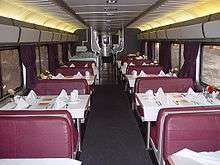
Pullman-Standard built 30 dining cars; Bombardier built another 39.[23] The dining cars can seat a maximum of 72 people on the upper level in tables of four. The galley occupies the entire lower level. At the center of the car are stairs down to the kitchen. A dumbwaiter is used to bring food and drink to the dining level, as well as to return dishes, glasses, and cutlery for washing.[28] A late 2010s overhaul added a refrigerator on the upper level for easy access and replaced incandescent lights with LED lighting.[55] As built, the Superliner I dining car weighs 174,000 pounds (78,925 kg); the Superliner II dining car weighs 158,070 pounds (71,699 kg).[25][17]
Amtrak rebuilt 17 Superliner I dining cars as diner-lounges in the late 2000s.[56] Dubbed the "Cross-Country Cafe", they were intended to reduce food service losses by replacing both a traditional dining car and the Sightseer lounge on long-distance trains. One end of the car was converted into a cafe area, with tables and a small serving area near the stairs to the kitchen. The other side remained dedicated to traditional diner seating, but the standard two-by-two tables were replaced by booths.[57]
Transition sleepers
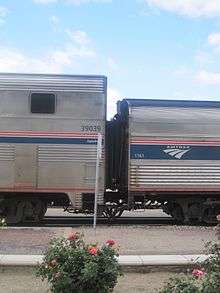
Bombardier built 47 "transition sleeper" or dormitory cars. The car had two purposes: to provide sleeping accommodations for train personnel; and to provide access to single level equipment from bi-level Superliner and Hi-Level cars. Hi-Level "step-down" coaches previously performed the latter role.[23] Most transition dormitory ("transdorm") cars have 16 roomettes on the upper level for crew accommodations, with an accessible bedroom and small crew lounge on the lower level. Bathrooms and showers are located on both levels. At one end of the car is a top level end-door; at the other end is a staircase and end door on the lower level.[28] On some trains, Amtrak makes the roomettes closest to the upper level end door available for sale to passengers.[58] The transition sleepers weigh 156,085 pounds (70,799 kg).[17]
Summary
Between them Pullman-Standard and Bombardier manufactured 479 cars:[59]
| Builder | Class | Type | Quantity | Original road numbers |
|---|---|---|---|---|
| Pullman-Standard | Superliner I | Coach-baggage | 48 | 31000–31047 |
| Pullman-Standard | Superliner I | Sleeper | 70 | 32000–32069 |
| Bombardier | Superliner II | Sleeper | 49 | 32070–32118 |
| Bombardier | Superliner II | Deluxe sleeper | 6 | 32500–32505 |
| Pullman-Standard | Superliner I | Sightseer lounge | 25 | 33000–33024 |
| Bombardier | Superliner II | Sightseer lounge | 25 | 33025–33049 |
| Pullman-Standard | Superliner I | Coach | 102 | 34000–34101 |
| Bombardier | Superliner II | Coach | 38 | 34102–34139 |
| Pullman-Standard | Superliner I | Diner | 39 | 38000–38038 |
| Bombardier | Superliner II | Diner | 30 | 38039–38068 |
| Bombardier | Superliner II | Transition dorm | 47 | 39000–39046 |
History
Superliner I
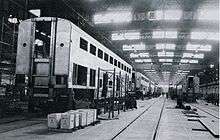
Amtrak ordered 235 Superliner I cars from Pullman-Standard on April 2, 1975, with deliveries scheduled for between January 1977 and June 1978. The order then consisted of 120 coaches, 55 sleepers, 34 diners, and 26 lounges. Amtrak soon increased the order to 284 cars: it added 30 coaches, 15 sleepers, 5 diners, and deleted 1 lounge.[60][61] The initial order cost $143.6 million;[62] with the additional cars and other payments the cost rose to $250 million.[63]
The railroad asked its employees to name the new cars, and announced the winning entry in its internal newsletter of June 1, 1977: "Vistaliner," harkening back to the Vista-Domes of the Chicago, Burlington and Quincy Railroad. But the newsletter went on to note that the name was already under copyright by another company, and so the cars would be dubbed "Superliners," a name created by Needham, Harper & Steers, then Amtrak's advertising agency.[64]
As the cars arrived in 1978 and 1979, Amtrak put them into use on short-haul routes radiating from Chicago. The first coaches entered regular service on February 26, 1979, running from Chicago to Milwaukee. The coaches, led by an EMD F40PH locomotive, displaced the regular Turboliner equipment.[65] The equipment continued to operate on the run for several weeks.[66] The Illini and Shawnee trains received Superliner coaches soon after; the first Superliner dining car ran on the Shawnee as a lounge.[lower-alpha 2]
Equipping the fleet

.jpg)
A public unveiling took place at Union Station in Chicago on October 11, 1979, followed by a short trip over the Burlington Northern Railroad to Lisle.[21] The following day, the Shawnee had the dubious distinction of the first Superliner accident, a minor collision with an Illinois Central Gulf Railroad freight train.[68]
Amtrak's first choice for Superliner assignments had been the financially-troubled Floridian, a Chicago–Florida long-distance train, but the two years' delay in delivery scuppered these plans.[69] Amtrak turned next to the Empire Builder. This long-distance train ran between Chicago and Seattle through the plains of Montana and North Dakota. Winters in that part of the United States are harsh, featuring both blizzards and cold temperatures. Traditional steam-heated equipment often broke down, causing Amtrak to cancel service. The Superliners, with their electrical head-end power, were far better suited for the conditions.[8] The Empire Builder became the first long-distance train to use Superliners, and the first train permanently assigned them, on October 28, 1979.[70] Amtrak's new national timetable depicted a Superliner coach on the front cover, and the listing for the Empire Builder carried a heading which read "Amtrak's Superliner is Somethin' Special."[71] At the same time, Superliners entered service on the short-haul Pacific International and Mount Rainier in the Pacific Northwest.[72]
With the Empire Builder in operation, Amtrak began re-equipping the remaining long-distance trains in the west. The second permanent Superliner train was the Desert Wind, then a day train between Los Angeles and Ogden, Utah, which gained coaches on June 30, 1980. The San Francisco Zephyr, a long-distance train on the traditional Overland Route between Chicago and San Francisco, followed on July 7, 1980; it received the first of the Sightseer lounges on January 6, 1981.[73] Amtrak assigned Superliners to another long-distance train, the Los Angeles–Chicago Southwest Limited, in October 1980. The Southwest Limited, formerly the Super Chief, traveled the same route as the El Capitan, whose Hi-Level cars had inspired the design.[74] The management of the Santa Fe, impressed by the design, permitted Amtrak to restore the name Chief to the train, and Amtrak renamed it the Southwest Chief on October 28, 1984.[75] The Chief was the first train to receive Superliner II sleeping cars in September 1993.[76]
The Coast Starlight began operating with Superliners in January 1981.[77] The Sunset Limited, a long-distance train running along the southern border of the United States between Los Angeles and New Orleans, gained them in February, resulting in a commendation from the Texas State Legislature.[78] The Pioneer gained Superliner coaches on April 26.[79] The Eagle, an overnight train between San Antonio and Chicago, began carrying Superliners in October on those days it connected with the Sunset Limited in San Antonio. Superliner assignments became permanent in the 1990s.[80] Amtrak estimated that reequipping a train with Superliners boosted ridership on it by 25%.[81] The last car of the order, a sleeper delivered in July 1981, was also the last car ever built by Pullman, and was named in honor of the company's founder, George Mortimer Pullman.[4]
In the mid-1980s Canada's Via Rail contemplated replacing its aging Budd-built steam-heated cars with Superliners. The order would have consisted of 130 cars, valued at CA$450 million, to be built by a consortium of Bombardier Transportation and the Urban Transportation Development Corporation.[82] Via tested several Amtrak Superliners in revenue service between Edmonton and Winnipeg in 1984–85.[83] Ultimately Via chose to rebuild its Budd cars to use HEP instead of ordering new equipment.[81]
Superliner II
Amtrak ordered 140 Superliner II cars from Bombardier Transportation in 1991; Bombardier had acquired the Superliner patents after Pullman-Standard's closure.[84] The order consisted of 55 sleeping cars, 38 coaches, 20 dining cars, 15 lounges, and 12 transition-dormitory cars. The initial order cost $340 million, and included an option for 39 additional cars.[85] In late 1993 Amtrak exercised the option for 55 cars at a cost of $110 million, bringing the total order of Superliner II cars to 195.[86] The option included ten dining cars, ten lounges, and 35 transdorms. Bombardier built the order in Barre, Vermont.[84]
The new order allowed the displacement of the remaining Hi-Level cars as well as the employment of Superliners on trains running with single-level cars. Amtrak converted three eastern long-distance trains to Superliners: the Chicago–New Orleans City of New Orleans (March 1994);[87] the Chicago–Washington, D.C. Capitol Limited (October);[88] and the Virginia–Florida Auto Train (March 1, 1995).[89] A project to enlarge the First Street Tunnel in Washington, D.C., enabled the Chicago–Washington Cardinal to begin using Superliners in September 1995; these were withdrawn in 2002 because of equipment shortages.[90] Superliners were used on the Chicago–Toronto International from November 1995 until early 2000.[lower-alpha 3] In 2017, Amtrak identified a need to replace the Superliners, noting that each car traveled the equivalent of "seven trips around the world" every year.[93]
See also
- California Car (railcar) – The first generation intercity railcar, based on the design of the Superliner
- Dome car
- Next Generation Bi-Level Passenger Rail Car
- Surfliner (railcar) – The second generation intercity railcar, based on the design of the Superliner
Notes
- ↑ Bombardier's specification for the Superliner II indicates a maximum design speed of 120 mph (193 km/h).[17]
- ↑ The Illini received Superliners in April and the Shawnee in June.[67]
- ↑ Sanders cites an equipment shortage for the withdrawal.[91] A report published by the Transportation Safety Board of Canada in 2002 faulted the design of the wheelchair-accessible bathroom in the Superliner and indicated that they were withdrawn for that reason.[92]
Footnotes
- ↑ Kelly, John (June 5, 2001). "Amtrak's beginnings". Classic Trains. Retrieved September 13, 2016.
- ↑ Simon & Warner 2011, p. 108
- ↑ "Railroad Sleeping, Passenger Cars Are Ordered By Amtrak". Valley Morning Star. April 2, 1975. p. 39. Retrieved February 7, 2017 – via Newspapers.com.

- 1 2 Solomon 2004, p. 129
- ↑ Zimmermann 2016, p. 54–55
- ↑ Weinman & Cavanaugh 1982, p. 30
- ↑ Solomon 2014, p. 288
- 1 2 Sanders 2006, p. 162
- ↑ Weinman & Cavanaugh 1982, p. 29
- ↑ Solomon 2004, p. 132
- ↑ Zimmermann 2004, p. 30
- ↑ Bing, Berry & Henderson 1996, p. A1-55
- 1 2 Johnston 1993, p. 37
- ↑ Bing, Berry & Henderson 1996, p. A1-65
- ↑ Bing, Berry & Henderson 1996, pp. 3–11
- ↑ Amtrak 2015, p. 43
- 1 2 3 4 5 6 "United States - Bi-level Superliner II". Bombardier Transportation. Archived from the original on April 12, 2001. Retrieved September 22, 2017.
- ↑ National RR Passenger Corp. v. State of Nev., 776 F.Supp. 528 (D. Nev. 1991).
- ↑ Campbell, Joel (August 21, 1988). "Amtrak Accused of Dumping at Helper". Deseret News. Retrieved September 19, 2017.
- ↑ "...And Congress Puts a Lid on It" (PDF). The Trainmaster. May 1991. p. 5.
- 1 2 Sheppard, Nathaniel, Jr. (October 12, 1979). "Amtrak Unveils a 'superliner' Fleet Of Rail Cars for Its Western Routes". The New York Times. Retrieved September 19, 2017.
- ↑ Johnston 1992, pp. 35–36
- 1 2 3 4 5 Simon & Warner 2011, p. 210
- ↑ ""Somethin' Special": A Superliner History". History Blog. Amtrak. September 30, 2013.
- 1 2 3 4 5 PTJ 1979b, p. 8
- ↑ Griswold 1957, pp. 138–241
- ↑ McGee, Bill (November 5, 2014). "Tale of the tape: Amtrak is more comfortable than airlines". USA Today. Retrieved September 19, 2017.
- 1 2 3 4 5 6 Mashburn, Craig. "Superliner Equipment". Amtrak Car Diagrams.
- 1 2 Weinman & Cavanaugh 1982, p. 28
- ↑ TSB 2002, p. 17
- ↑ Foster 1996, p. 120
- 1 2 Amtrak 1990, p. 13
- ↑ Simon & Warner 2011, p. 218
- ↑ "Smoking Cars". RailNews (401): 27. April 1997.
- ↑ "Analysis of Cost Savings on Amtrak's Long-Distance Services" (PDF). Office of Inspector General for the Department of Transportation. July 22, 2005. p. 9.
- ↑ Sachs, Ben (May 21, 2012). "A memory of the smoking car". Chicago Reader. Retrieved September 19, 2017.
- ↑ Simon & Warner 2011, pp. 212–213
- ↑ Simon & Warner 2011, p. 221
- ↑ Bandrapalli, Suman (October 19, 1997). "More travelers opting for the rails". Chicago Sun-Times. Retrieved January 7, 2017 – via HighBeam Research. (Subscription required (help)).
- ↑ Simon & Warner 2011, p. 222
- ↑ "Amtrak Coast Starlight to offer Business Class Service" (PDF) (Press release). Amtrak. July 2, 2015. Archived from the original (PDF) on February 7, 2016.
- 1 2 Simon & Warner 2011, p. 219
- ↑ "Rolling Stock Roster". On Track On Line. December 31, 2016. Retrieved January 7, 2017.
- ↑ PTJ 1979b, p. 9
- ↑ "Superliner Roomette". Amtrak. Archived from the original on January 5, 2017. Retrieved January 15, 2017.
- ↑ "Superliner Bedroom". Amtrak. Archived from the original on August 19, 2016. Retrieved January 15, 2017.
- ↑ "Superliner Family Bedroom". Amtrak. Archived from the original on August 19, 2016. Retrieved January 15, 2017.
- ↑ "Superliner Accessible Bedroom". Amtrak. Archived from the original on August 19, 2016. Retrieved January 15, 2017.
- ↑ "Superliner Bedroom Suite". Amtrak. Archived from the original on August 4, 2016. Retrieved January 15, 2017.
- ↑ Ingles 1979b, p. 16
- ↑ Johnston 1993, p. 38
- ↑ Simon & Warner 2011, p. 216
- ↑ Young, David (January 25, 1981). "Amtrak upgrading its western trains". Chicago Tribune.
- ↑ "Piano lounge in a Sightseer Lounge car, 1980s". Amtrak: History of America's Railroad. March 7, 2014.
- ↑ Johnston 2017, p. 23
- ↑ Simon & Warner 2011, pp. 218–219
- ↑ Johnston 2008a, p. 22
- ↑ Johnston 2008b, p. 27
- ↑ Simon & Warner 2011, pp. 212–223
- ↑ Amtrak 1975, p. 16
- ↑ "From Ugly Duckling To Graceful Swan". On Track. 1 (1): 13. June 1981.
- ↑ Gruber, William (December 14, 1975). "No longer a sleeping giant, Pullman growing overseas". Chicago Tribune.
- ↑ Shifrin, Carole (October 12, 1979). "Supertrain Coming on 7 Amtrak Routes". The Washington Post. Retrieved September 19, 2017.
- ↑ "Name The Bi-Level Contest Winners Picked". Amtrak NEWS. 4 (10): 2. June 1977.
- ↑ Ingles 1979a, p. 14: "For aboard train 337 when F40PH No. 230 accelerated coaches 34014 and 34013 out of Union Station..."
- ↑ Sanders 2006, p. 181
- ↑ Sanders 2006, p. 103
- ↑ NTSB 1980, p. 10
- ↑ Sanders 2006, p. 90
- ↑ Sanders 2006, p. 171
- ↑ "National Train Timetables". Amtrak. October 28, 1979.
- ↑ PTJ 1979, p. 6
- ↑ Sanders 2006, p. 154
- ↑ Sanders 2006, p. 133
- ↑ Sanders 2006, p. 128
- ↑ Sanders 2006, p. 134
- ↑ "Untitled" (PDF). The Trainmaster (237): 3. February 1981.
- ↑ "Commendation–National Railroad Passenger Corporation". H.C.R. 64, of February 20, 1981. p. 4061.
- ↑ Sanders 2006, p. 155
- ↑ Sanders 2006, p. 120
- 1 2 Gormick, Greg (June 6, 1987). "How to beat the railway blues: Amtrak given new car boost but VIA stuck with old stock". The Toronto Star. p. B4.
- ↑ Stewart-Patterson, David (June 11, 1986). "Via Rail close to deal on double-decker cars". The Globe and Mail. p. B7.
- ↑ Brunt, Stephen (February 20, 1985). "Via Rail seeking two-tier coaches". The Globe and Mail.
- 1 2 Johnston 1993, p. 36
- ↑ Phillips, Don (April 23, 1991). "AMTRAK TO BRING DOUBLE-DECKER TRAINS TO D.C." Washington Post. Retrieved September 19, 2017.
- ↑ "Amtrak Orders 55 Cars". The New York Times. December 9, 1993. Retrieved September 19, 2017.
- ↑ Sanders 2006, p. 98
- ↑ Sanders 2006, p. 48
- ↑ "Bi-level Superliner". Railway Age. 196 (3): 26. March 1995. Retrieved January 14, 2017. – via EBSCO's Academic Search Complete (subscription required)
- ↑ Sanders 2006, p. 51
- ↑ Sanders 2006, p. 208
- ↑ TSB 2002, p. 25
- ↑ Amtrak 2017, p. 3
References
- "The Journal". Passenger Train Journal. 11 (4): 5–7. August 1979. ISSN 0160-6913.
- "Superliner Specs". Passenger Train Journal. 11 (8): 8–10. December 1979. ISSN 0160-6913.
- Amtrak (1975). Annual Report.
- "Amtrak's Passenger Trains" (PDF). Amtrak. August 1990.
- Amtrak (October 27, 2015). "Capital Investment Plan for Amtrak Equipment Deployed in State Corridor Service FY2016 – FY2020" (PDF).
- Amtrak (June 27, 2017). "Amtrak Five Year Service Line Plans: Fiscal Years 2017-2021: Long Distance Service Line" (PDF). p. 3.
- Bing, Alan J.; Berry, Shaun R.; Henderson, Hal B. (1996). Design Data on Suspension Systems of Selected Rail Passenger Cars (PDF). Washington, D.C.: Federal Railroad Administration.
- Foster, Gerald L. (1996). A Field Guide to Trains of North America. Boston: Houghton Mifflin. ISBN 0-3957-0112-0.
- Griswold, Wesley S. (January 1957). "Riding the Santa Fe's Split-Level Train". Popular Science: 136–139, 240–241.
- Ingles, J. David (May 1979). "How super are the Superliners?". Trains. 39 (7): 14. ISSN 0041-0934.
- Ingles, J. David (June 1979). "Superliner high points". Trains. 39 (8): 16–17. ISSN 0041-0934.
- Johnston, Bob (June 1992). "Amtrak's design on the future". Trains. 52 (6): 32–41. ISSN 0041-0934.
- Johnston, Bob (December 1993). "Superliner II's make their debut". Trains. 53 (12): 36–38. ISSN 0041-0934.
- Johnston, Bob (March 2008). "Diner-lounge debut: Take two!". Trains. 68 (3): 22. ISSN 0041-0934. Retrieved January 7, 2017. – via EBSCO's Academic Search Complete (subscription required)
- Johnston, Bob (July 2008). "Dorm car secrets revealed". Trains. 68 (7): 27. ISSN 0041-0934. Retrieved January 7, 2017. – via EBSCO's Academic Search Complete (subscription required)
- Johnston, Bob (August 2017). "There's Beech Grove". Trains. 77 (8): 22–23. ISSN 0041-0934.
- National Transportation Safety Board (April 3, 1980). "Head-end Collision of Amtrak Train No. 392 and ICG Train No. 51, Harvey, Illinois, October 12, 1979" (PDF).
- Sanders, Craig (2006). Amtrak in the Heartland. Bloomington, Indiana: Indiana University Press. ISBN 978-0-253-34705-3.
- Simon, Elbert; Warner, David C. (2011). Amtrak by the numbers: a comprehensive passenger car and motive power roster, 1971-2011. Kansas City, Missouri: White River Productions. ISBN 978-1-932804-12-6.
- Solomon, Brian (2004). Amtrak. Saint Paul, Minnesota: MBI. ISBN 978-0-7603-1765-5.
- Solomon, Brian (2014). GE and EMD Locomotives: The Illustrated History. Minneapolis, Minnesota: Voyageur Press. ISBN 978-0-7603-4612-9.
- "Crossing Collision/Derailment Via Rail Canada Inc. Passenger Train No 85 Mile 33.54, Goderich-Exeter Railway (GEXR) Guelph Subdivision Limehouse, Ontario". Transportation Safety Board of Canada. December 17, 2002. Retrieved January 15, 2017.
- Weinman, Michael R.; Cavanaugh, Raymond R. (August 1982). "How to Design a Superliner". Trains. 42 (10): 26–30. ISSN 0041-0934.
- Zimmermann, Karl (2004). All Aboard! Passenger Trains Around the World. Honesdale, Pennsylvania: Boyds Mills Press. ISBN 978-1-59078-325-2.
- Zimmermann, Karl (Winter 2016). "Riding High: Santa Fe's Big Move of 1956". Classic Trains. 17 (4): 50–57. ISSN 1527-0718.
External links
| Wikimedia Commons has media related to Superliner passenger cars. |
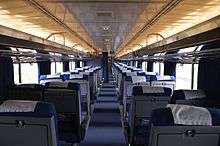
.jpg)
